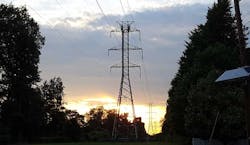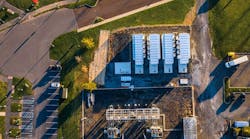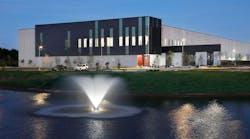SAN FRANCISCO – The data center industry’s growing appetite for power is testing its relationship with electric utilities, many of whom are struggling to meet cloud builders’ demand for renewable energy.
Leaders from the two industries recently convened for DCD Energy Smart, the first in a series of events to explore ways to build better collaboration. Not everyone was on the same page, but the discussion identified looming challenges, as well as areas where utilities and data centers may be able to work together for change.
“The reason we’re here is the quantity of energy being used by the data center industry,” said Mark Mills, Senior Fellow at The Manhattan Institute. “The growth rate of the power used for data is twice the power growth for everything else. It’s going up a thousand-fold.”
Understanding future capacity demand requires communication, said Mills.
“The two worlds are intersecting,” he said. “Whatever the challenges are today, they’ll become far more interesting and challenging in the future.”
Here’s an overview of the DCD Energy Smart conference and some highlights of the conversations.
Meeting Demand for the Growing Cloud
One of the challenges is the complexity of the electric utility industry, where companies operate under a variety of business models and regulatory oversight. Utility executives say the industry is in a state of flux in supply, demand and policy. Federal and state policy goals are diverging, and business models are evolving as the industry seeks to adapt to energy storage, smart grid technology and microgirds.
“The utility sector is going through revolutionary change, particularly in the distribution system,” said Leanne Swenson, Principal Manager, Distribution Engineering, Southern California Edison (SCE), which serves 15 million customers. “Data centers have always posed a challenge for distribution. We have to find ways to partner and come together. We have to find ways to support one another.”
One of the challenges is that the data center industry has been experiencing strong growth in power use, while many other customer verticals have had static demand. This bears careful watching, according to David Murray, the President of Hydro-Quebec Distribution, which delivers power from Quebec’s massive hydro-electric dams, and was a lead sponsor of the Energy Smart event.
“We’re going to be the gating mechanism (for data center growth) if we don’t understand the demand coming at us,” said Murray.
That sentiment was echoed Don Paul, Executive Director of the USC Energy Institute, which studies ways for the utility industry to improve efficiency and adopt renewable energy sources like wind and solar power.
“The explosion of the digital world creates insecurity that grows along with it,” said Paul. “If you really have that kind of data explosion, and you don’t have equivalent gains in efficiency, you will need way more electricity. That’s not in anyone’s forecast.”
The Cost of Grid Redundancy
Utilities shouldn’t count on data centers solving the problem by offsetting cloud-driven usage gains with improved efficiency.
“We already drove out the waste in the industry,” said Dean Nelson, Head of Uber Compute. “All of the efficiency gains have already been consumed.”
Reliability is also an issue, according to Nelson, who noted the massive investment by data centers in redundant infrastructure for backup power.
Dean Nelson, Head of Uber Compute, speaks at the DCD Webscale event. (Photo: Rich Miller)
“There’s hundreds of millions of dollars of replication going on because we don’t trust the utility to be up,” said Nelson. “We truly could change the grid.”
“Historically, there was always a buffer between the utility and the server,” said Peter Gross, the VP of Mission Critical Systems as Bloom Energy. “It’s a different world in 2017. This new architecture has created to concept of distributed resiliency. Now we have a bunch of different models changing the topology of power.”
Bloom Energy is positioning its fuel cells as a tool to eliminate the need for expensive UPS systems and emergency backup generators. Other approaches seek to reduce the number of power conversions between the grid and the server (such as Google’s 48V rack) or position fuel cells at the rack level to power servers. Still other approaches seek to place servers at key intersections on the utility grid.
Frustration Over Renewable Energy
New power architectures are a potentially disruptive trend. But some panelists expressed frustration that the data center industry must innovate to address problems in the utility sector.
“We have always locked horns with utilities, particularly on sustainability,” said Gary Demasi, Global Director of Data Center Energy and Location Strategy at Google. “Over the last 10 years, we have worked to challenge the utility model. Utilities today are not equipped to deliver what we need. We have had to build energy expertise within our own company.”
Google has taken a leadership position in procuring renewable energy to power its data centers, lining up power purchase agreements (PPAs) totaling more than 2.6 gigawatts of wind and solar energy capacity. To meet its goals, it formed the Google Energy subsidiary, which has a government license to buy and sell electricity like a utility.[clickToTweet tweet=”Google’s Gary Demasi: We have often locked horns with utilities, particularly on sustainability.” quote=”Google’s Gary Demasi: We have often locked horns with utilities, particularly on sustainability.”]
“We’re seeing some utilities be progressive, and other utilities that are sheltering in place and hoping the world doesn’t change around them,” said Adam Kramer, Executive VP of Strategy at Switch, which has committed to power the entirety of its network of massive data centers with 100 percent renewable energy. .
Kramer said the company has been impressed with Consumers Energy, the utility it is working with on its Pyramid Campus data centers in Grand Rapids, Michigan. In May, Consumers filed plans with the state to offer a green energy tariff that would allow Switch to purchase power from a new wind energy project. That’s a contrast from the situation in Switch’s home state of Nevada, where it struggled to provision solar energy and eventually was a key player in a voter referendum to open the state’s energy markets.
Kello Gallo of BSR (left) and Patrick Flynn from Salesforce participate in a panel at DCD Energy Smart in San Francisco. (Photo; Rich Miller)
Not all data center customers have the ability to form their own energy company or the buying power to shift an entire state’s energy market. A group of large users is working with non-profit BSR, which has developed the Corporate Colocation and Cloud Buyers’ Principles to outline best practices for using renewable energy in multi-tenant facilities. These users’ appetite for green power won’t change with the Trump administration’s decision to exit the Paris Agreement on climate change, according to Kelly Gallo, Manager of Advisory Services at BSR.
“Environmental responsibility is no longer a trend, but has become the new normal,” said Gallo. “We really have seen the private sector step up, and say that if the US government isn’t going to lead, then we will. We have the resources. It’s not just about doing the right thing, but what makes business sense.”
Some panelists asserted that the limited progress on procuring clean power through utilities should motivate the data center industry to step up its activism.
“People are lighting money on fire everywhere you look,” said Patrick Flynn, Senior Director of Sustainability at Salesforce. “The cloud runs on electricity. Believe it or not, we still get our energy from digging up long-dead plants and animals and lighting them on fire. If we can provide the right incentives, we can drive change. We can drive the behavior that we want. We can move digital demand for work at the speed of light.”
Areas of Opportunity
The panels examined several areas where collaboration could help. One of these is direct access, which allows customers to procure energy from outside their utilities’ service area, with the local utility providing transmission to the customer.
Infomart Data Centers President and CEO John Sheputis (right) makes a point at the DCD Energy Smart conference. At left is Dale Sartor from Lawrence Berkeley National Laboratory. (Photo: Rich Miller)
“We want to exercise our own choice,” said John Sheputis, President and CEO of Infomart, which uses direct access programs to offer renewable energy to customers in San Jose and Portland. “We fundamentally believe in procuring 100 percent renewable power. The only reason we can do that is that we went to the effort to procure that choice.
“What we look for is choice, and a utility that understands that a data center is a unique customer,” said Sheputis. “We give a lot of thought to where data centers should be. There’s an inconsistency of choice around the country.”
Several of the day’s panels noted the low data center participation in demand response programs, which are voluntary programs that compensate customers for reducing their use of electricity in peak load times.
“One of the fundamental issues seems to be communication, or the lack thereof,” said Dale Sartor, Staff Scientist and Engineer at Lawrence Berkeley National Laboratory. “No data centers are taking advantage of demand response. The reason is that we have no incentive to do it. It’s important to recognize that the market has tremendous pull. We can solve each other’s problems very cost efficiently and help save the environment.”
The Road Ahead
A number of factors will mold the relationship between the two industries. It’s possible that utilities will wind up working with a smaller universe of data center customers.
“What we see today is a very aggressive consolidation,” said Gross. “In five years or so, we will see 30 or so mega data center owners around the world.”
Jim Connaughton, the CEO of Nautilus Data Technologies, sees a need for change in the utility industry.
“We have all this opportunity, and we can only get there through markets,” said Connaughton. “We have to restructure our utility industry to respond to the market. When you restructure, innovation explodes.”
“Culture clash is not easy to fix,” said Mills of The Manhattan Institute. “I don’t think there’s full appreciation of the change that’s going on. The pace of change in these two industries is not going to comfortably intersect.”






